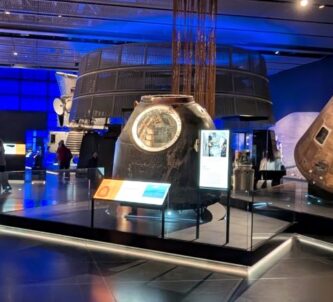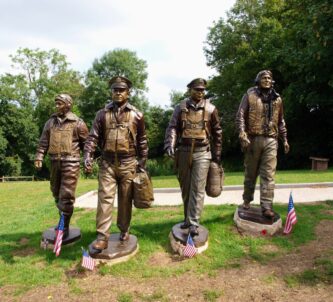This is one of the latest variations of Supermarine Spitfire and this particular one was built right at the end of WW2, in June 1945.
Spitfire TE462 can be found on static display at The National Museum of Flight, Scotland.
Truthfully, she’s my least favourite version of the Spitfire because of her clipped wings, which I think spoil the classic lines of the Spitfire.
The reason for the clipped wings is, of course, a practical one – they weren’t going out of their way to uglify (sic) her! The clipped wing significantly increased the roll rate – enabling her to compete with the Focke Wulf 190 – and marginally increased her speed at low levels, which is what she was designed for…
TE462 is a Mk XVIe (LF) Spitfire. The Mk XVI is pretty much the same as a Mk IX Spitfire, except the engines are different.
The Mk IX Spitfire had a Rolls Royce Merlin 61 supercharged engine, optimised for max performance at heights between 20,000 – 40,000ft – a High Level Fighter “(HF)”.
The Mk XVI had a Merlin 66 engine, designed for max efficiency 20,000ft and below – a Low Level Fighter, hence (LF).
Actually, Spitfire TE462 had a Merlin 266 engine. Not all Merlin engines were built by Rolls Royce. Many were built under licence by Packard in the USA. The ‘2’ in 266 denotes a Packard Merlin 66 – they were slightly different shape and required different tooling. TE462’s Merlin engine was shipped over the Atlantic to the Vickers-Armstrong (Supermarine’s parent company) aircraft factory at Castle Bromwich where she and 1,053 other XVIs were built.
Most Mk XVIs had clipped wings. The ‘e’ in her type designation denotes a version E wing. Spitfire wing variations were mostly about construction and gun emplacement rather than shape.
Sadly TE462 was built too late to see any action. She was delivered to the RAF on 29 June 1945 and almost immediately placed in storage as ‘surplus to requirements’. In February 1950 she was allocated to RAF Finningley, Yorkshire as a ‘communications aircraft’. After a small ‘prang’ (possibly a wheels up landing) she spent a short period with 101 Flying Refresher School at Finningley, before making her last flight on 15 Oct 1951.
What do you think? Do you like the clipped wing Spitfires?








MK 16 had a specific purpose. Played a memorable role in attacking the V-2 launch sites on the Dutch coast. Clipped wings are synonymous with the battles over Holland in 1945, totally different role than Battle of Britain.
Hi Dwayne, Yes, as I remember it, the clipped wings gave it a faster roll rate; made it more agile…?
(Duh! I should have read my post again before being so quick to comment. Yes that was exactly the purpose!)
Love the clipped mk16. A superb ground attack fighter.